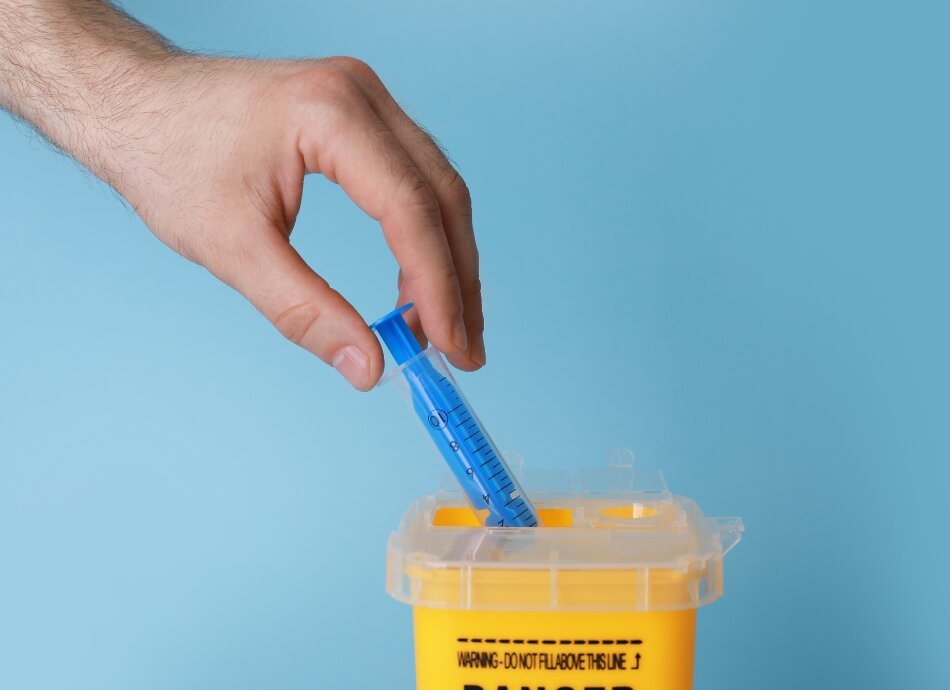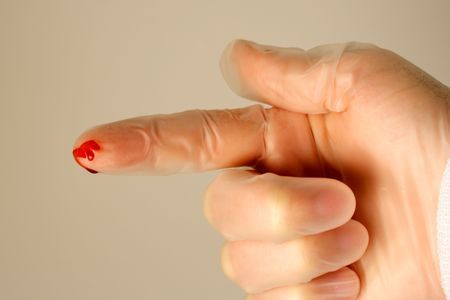Needlestick injuries
What should I do if I injure myself with a used needle?
Key points about needlestick injuries
- If you pierce or puncture your skin with a needle that’s been used by or on someone else, clean the wound and see a healthcare provider straight away.
- A needlestick injury puts you at risk of infection with viruses such as hepatitis B, hepatitis C or HIV.
- The risk depends on several things, such as whether the person who used the needle has an infection and how much virus is in their blood.
- The best way to prevent needlestick injuries is to put used needles into a sharps container – you can get these from your pharmacy.

A needlestick or sharps injury is when your skin is accidentally pierced by a needle or other sharp object (such as a syringe, scalpel or broken glass) that’s been in contact with blood, tissue or other body fluids from another person. This can happen at work (eg, if you’re a healthcare worker, cleaner or tattoo artist) or if you come across a used needle at home or in the community.
A needlestick injury puts you at risk of infection with viruses such as hepatitis B, hepatitis C or HIV.

Image credit: 123rf
Needlestick injuries in the community
Injuries from discarded needles in the community aren’t common and infections from these injuries are rare. However, if you pierce or puncture your skin with a used needle, follow this first aid advice immediately:
- Let the wound bleed freely.
- Wash the wound with soap and running water.
- If soap and water aren’t available, use an alcohol-based hand rub or solution.
- Go straight to your medical centre or an urgent care centre. If these are not available go to the nearest hospital emergency department.
Your healthcare provider will assess the risks to your health and ask about your injury, including how and when it happened and who had used the needle. They’ll decide what tests you need and whether you need any treatment to prevent infection.
They’ll also tell you if you need to follow any extra precautions such as practicing safe sex and avoiding blood donation. Check with your healthcare provider about how long you need to follow these extra precautions.
Needlestick injuries among healthcare workers
Healthcare workers are generally more at risk of accidental exposure to infected blood from a used needle or other sharp object (this is called occupational exposure). If you’re at work, you should follow your local occupational health guideline for needlestick injuries.
The concern with a needlestick injury is the risk that any blood on the needle may contain viruses such as hepatitis B, hepatitis C or HIV, that might be passed on to you.
The risk of transmission following a needlestick injury depends on several factors:
- whether the person who previously used the object had an infection
- the level of virus in their blood
- the amount of blood involved
- the type of needle or syringe
- the time that has passed since it was used
- the type of injury.
You must get rid of your used needles and syringes safely.
- Keep them out of reach of children and pets, and places where they could hurt others.
- You can do this by buying a sharps container from your pharmacy. This is a special container made of hard plastic that has a tight-fitting lid so used needles and syringes can be stored securely. You can also make your own. Read more about sharps containers.
- Once your sharps container is full, take it to your pharmacy and they will dispose of it safely.
- Don't flush used needles and syringes down the toilet or put them in household or public rubbish or recycle bins.
- You can talk to your pharmacist about how you can get rid of your needles and syringes safely.

Image credit: Healthify He Puna Waiora
Apps
References
- Blood or body fluid exposures(external link) Auckland Regional HealthPathways, NZ, 2024
- Needlestick injury(external link) Better Health Channel, Australia
- Needlestick injury(external link) Patient Info Professional, UK, 2022
Needlestick injury guidelines(external link) Starship, NZ, 2021
Exposure to body fluids – keeping the primary healthcare team safe(external link) BPAC, NZ, 2014
Needlestick injury information(external link) Awanui Labs, NZ
Needlestick injury(external link) Patient Info Professional, UK, 2022
Managing sharps injuries(external link) BMJ visual summary, UK, 2015
Credits: Healthify editorial team. Healthify is brought to you by Health Navigator Charitable Trust.
Reviewed by: Dr Sara Jayne Pietersen, FRNZCGP, Auckland
Last reviewed:





